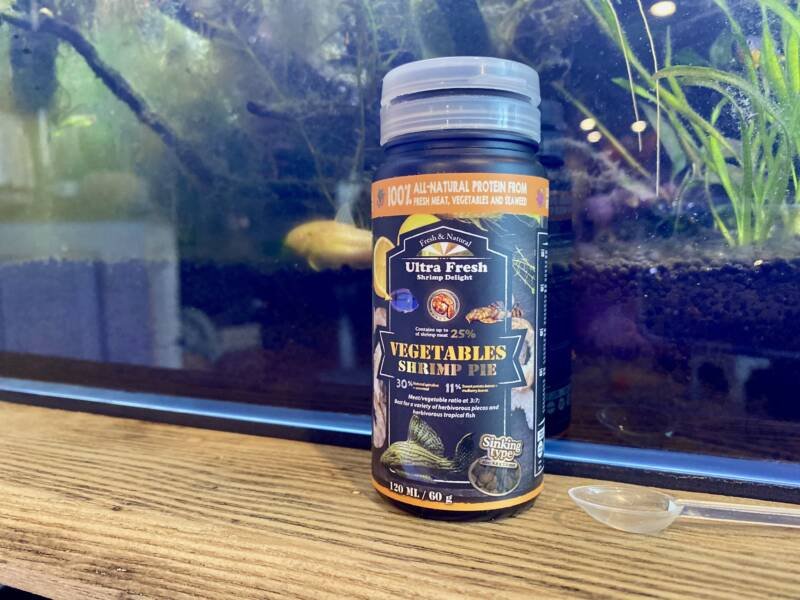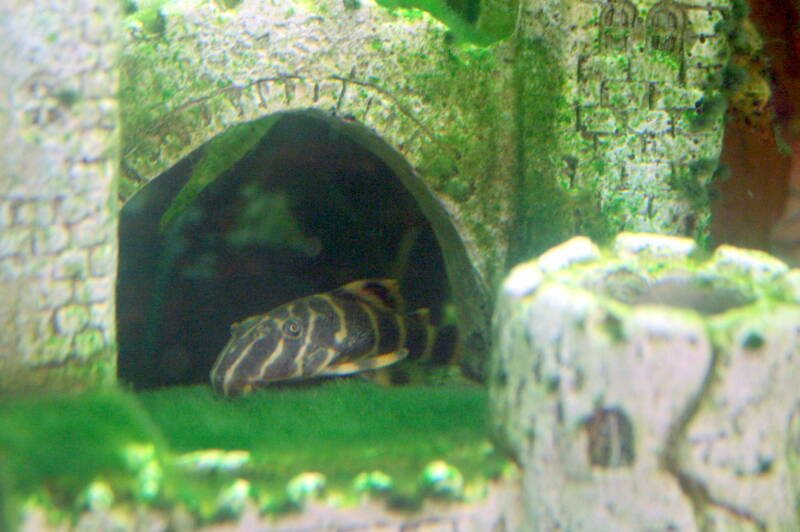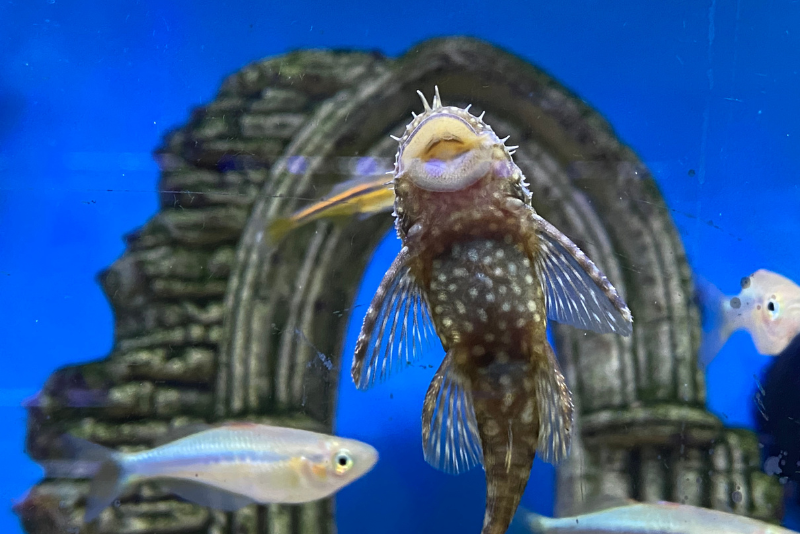Clown plecos are gentle-tempered, bottom-dwelling fish that can exhibit playful antics. But, best of all Clown Plecos are neat looking, and have moderately low-maintenance needs.
The proper care for your Clown Pleco is easily manageable for any dedicated aquariust as long as you know the proper conditions and provide a bottom-dwelling fish specific diet your, pleco with thrive.
In this detailed and complete Clown Pleco care guide, we’ll dive into everything you need to know.

At a Glance
| Tank Size: | 20 gallons, minimum tank size |
| Group Size: | Single or in groups |
| Water Temperature: | 75 to 82°F (23.89 to 28°C) |
| pH: | 6.8 to 7.6 |
| Diet: | Omnivore |
| Lifespan: | 10 to 12 years |
| Breeding: | Egg layer |
| Adult Size: | 3 to 5 inches (7.6 to 12.7 cm) |
| Usual Place in the Tank: | Bottom |
In this article
Food and Diet
The ideal clown pleco diet will be a combination of algae, driftwood, vegetables, and occasional protein. Naturally, they are omnivores, so like any fish kept in captivity a balanced and varied diet is the ‘secret sauce’ to a healthy long living fish.
With that, being said, a top reason clown plecos die is due to starvation. This bottom-feeding species can scavenge many types of foods, but the most important to include in the clown pleco’s diet is driftwood and the algae that grow on it. They will also feed off any algae or biofilm growing on rocks or decorations in the tank. A common misconception is that this is enough food for a pleco to survive, and sadly it is not.
In order to ensure your clown pleco diet is adequate, you’ll need to supplement with various sinking, wafer-style, plant-based commercial food, and organic vegetables.
Let’s start with the wafers! Unfortunately, the quality of sinking, wafer fish food is often very poor, the ingredients list is simply junk. Sigh. However, there are some trusty brands that exist. The key thing is selecting a “vegie” or “algae” based one.
Just because the food label says “algae wafer” does NOT mean that is actually the main ingredient. For example Omega One Veggi Wafers are not suitable for a herbivorous plecos.
Caution:
Our favorite food for plecos and other plant-based bottom feeders are these small wafers. They are made with an excellent, whole source ingredient list.
My Top Pick:

Round out your pleco’s diet with other vegetable sources.
They will eat yams, cucumbers, lettuce, zucchini, peas, or blanched vegetables. Adding in these vegetables may keep your plecos from eating your aquatic plants.
In addition, toss in some sinking algae wafers or spirulina pellets daily.
Finally, offer weekly protein meals of bloodworm, brine shrimp, or daphnia. These protein sources are essential when preparing to breed your clown plecos.
Feed your fish in the evening as they are nocturnal.
How many per gallon?
Plan on a 20-gallon tank to accommodate a single clown pleco. Add on 20 gallons for each additional male and 10 gallons for each female.
These tank sizes will allow the fish to establish their own territories and should reduce incidents of aggression.
Tank setup
Once you have determined the tank size you need, consider a tank that is longer than it is tall. As your clown pleco spends most of its time along the bottom of the tank, this will allow more territory.
Other things to consider are décor that mimics the clown pleco’s natural habitat and appropriate filtration for the waste the fish will produce.

Decorations
Because the clown pleco is a bottom dweller, start with a fine, soft substrate. Live plants, such as hornwort or floating plants, will provide nice, shaded areas for your fish.
Because your fish may snack on any plants you include, consider both fast and slow-growing options.
Adding rocks and caves will give your clown pleco places to shelter during the day as well as surfaces on which algae and biofilm can grow. Your clown pleco will snack on these growths.
Most importantly, place plenty of driftwood. This “decoration” is essential for the overall health of your clown pleco. In the wild, these fish get most of their nutrients from feeding off driftwood.
Water Conditions
The clown pleco’s natural habitat includes significant seasonal variations in water parameters, including temperature and water hardness. These changes signal the breeding season, among other things.
Do not take the clown pleco’s tolerance to mean that it is acceptable to ignore water quality. As with any fish, stable water and tank conditions mean healthier fish.
Keep the water temperature in the range of 73 to 82 degrees Fahrenheit (23 to 28 degrees C).
The pH range should be between 6.8 to 7.6 and the hardness around 10 dGH. Perform regular partial water changes to keep the chemical levels and buildup of wastes in check.
Equipment
Install a heater to keep the tank on the warmer side of the temperature range. In addition to maintaining a stable temperature, a heater will also allow you to lower the water temperature when you are ready for your fish to breed.
Because the clown pleco produces a higher amount of waste, plan on a quality filtration system. A good-sized HOB or canister filter or one with replaceable filters will do well.
Your filtration system should produce a moderate water flow. Add an air stone to ensure the bottom area of the tank is well oxygenated.
Tank Mates
We have already mentioned the clown pleco’s peaceful nature. As such, they are a great tank mate for similarly-sized, non-aggressive fish.
The key is to avoid any aggressive fish or any larger species that would consider the slower clown pleco a snack.
Consider the following to pair with your clown pleco:
- Tetras
- Rasboras (smaller types)
- Dwarf gouramis
- Minnows (white cloud mountain, rosy reds)
- Loaches (except for Clown Loach)
- Corydoras aka. Cory Catfish
- Shrimp
Avoid the following:
- African cichlid
- Flowerhorn cichlid
- Clown Loach
- Barbs
- Oscars
- Any larger, more aggressive fish
Lifespan
You will have plenty of time to bond with your clown pleco. This long-lived species can grace your tank anywhere from 10 to 12 years.
Naturally, your pleco’s lifespan depends heavily on the care you provide and overall living conditions.
Poor or incorrect diet, bad water quality, water that is too cold, and high stress due to these changes or other aggressive fish can quickly shave years of their life.
So, even though they are deemed a hardy species of fish, this doesn’t mean they can live a full lifespan with subpar care.
The most common mistakes beginner fish-keepers make with clown plecos is not having enough variation in the diet, not ensuring the pleco is eating enough (starvation), stress from bully fish, and too cold of water.
Appearance

Like most plecos species, clown plecos have a pointed, round nose that widens to a broad head and slowly tapers toward the tail. Their pectoral, dorsal, and caudal fins can be expanded or folded down when the fish is at rest or swimming. The dorsal fin expands down a majority of the body length, and when perked up can be quite tall and pronounced! When the pleco matures, the dorsal fin can be the highlight feature that makes them stand out along the bottom.
Their underside is flat and smooth and they have a suckermouth that moves independently in circles as they munch along. Sometimes this feature is what makes plecos so enjoyable to keep – one can get lost in time watching a little pleco methodically work its way across the driftwood, rocks, and plants sucking algae.
Because they are bottom-dwelling fish, their eyes are positioned on the top of the head. This is so they can see predators coming down from above, and they use the sensory elements in their mouths to find food, rather than their eyes.
The color patterns on the clown pleco are especially beautiful. The fish’s body is black or dark brown with white-yellow bands that traverse the circumference. This bold contrast of unique patterns makes them stand out drawing your eyes straight to them!
Each Clown pleco individual has a distinct color pattern, making no two exactly alike, but the overall result is a rippled effect. The vibrancy of the colors depends on genetics, age, and the overall health of the fish.
Plecos move in a cute antic way. Often they will almost hop-skip across the bottom, kicking it in reverse and then forward again. They will span the tail, dorsal, and caudal fins take a powerful pull, then tuck them down tight to the body and glides forward like a torpedo.
Not to be confused, but there is another pleco, called a Mega Clown Pleco (Hypancistrus sp.) Which is still a fantastic, beautiful pleco but genetically different.

Gender Differences
Determining the gender of your clown pleco can be a challenge, especially when the fish are young. Once they reach breeding age or about one year old, you may notice differences in their body sizes and shapes.
Females can be larger and more rounded when they are carrying eggs.
Males tend to be slimmer. Also, males may have more whiskers around the mouth as well as long odontodes on the head and dorsal fin.
Clown Pleco Size
When you purchase a clown pleco, it will typically be a juvenile, around 1 to 2 inches (2.54 to 5 cm).
As they grow to maturity, the fish will reach a length between 3 to 4 inches (8 to 10 cm). However, some clown plecos can reach 5 inches! Due to their small size, clown plecos are considered “dwarf pleco” and suitable for smaller tank sizes.
Genetics, environmental aspects, such as water quality, or the quality of their diet can impact the adult size of your fish. Your Clown pleco should reach max length within its second year of age.
Behavior
The clown pleco is a naturally tranquil species. They prefer minding their business, scooting around the bottom or sides of the tank, feeding off driftwood and algae, and rarely interacting with other fish.
You’ll frequently find your clown pleco resting on top of driftwood, or scraping away at the algae on the wood’s surface. In short clown plecos LOVE driftwood! This can be a surprising behavior (if you are a new pleco owner), in the amount and frequency you will observe your pleco eating the driftwood.
They get along well with other species. Occasionally, male clown plecos can show slight territorial behavior toward other bottom-dwelling species. This behavior is increased if you have more than one clown pleco (male + female to other fish or male + male with each other) and they become territorial for optimal hiding places.
Ensuring that the tank size is adequate to allow each male to establish a territory can help to alleviate any possibility of aggression, but no guarantee. If two males are on the same prime piece of food or driftwood, there might be a ‘show-down’.
These fish are nocturnal. They tend to hide in shaded areas, such as caves or driftwood, during the day and roam around feeding at night.
Therefore, it is not uncommon to rarely see your clown pleco frequently during the day. A great way to enjoy your clown pleco is to have a blue light ‘moon shine’ setting on your aquarium light, one like the Fluval lights offer.
Clown Pleco Natural Habitat
The Clown plecostomus (scientific name: Panaque maccus) natural habitat is the warm waters of Venezuela, South America. These waters are soft, with a neutral pH, a swift current, and heavy vegetation.
Clown plecos live primarily in the Caroni and Apure River basins – two major river systems that cover a good amount of territory.
These rivers’ bottoms are littered with plant matter, rocks, and most importantly, sticks and driftwood due to the heavily forested regions through which these rivers flow. Decaying vegetation often results in murky water and low-light conditions. Due to these conditions in their natural habitat, Clown plecos adapt well, being hardy fish like many aquarium catfish species. As well, vegetation, algae, and woody hiding places are crucial to pleco survival.
Seasonal variations impact the habitat’s water parameters. The clown pleco is accustomed to the changes in water temperature, pH, and hardness brought on during dry, cool winters and warm, rainy summers.
In an aquarium setting, this is important to remember as these water parameters change, they are the key triggers associated with the fish’s breeding cycle.
Breeding
Breeding your clown plecos can be challenging in a home setting as certain criteria trigger the species to spawn.
Set up a separate breeding tank with plenty of driftwood and a PVC or wooden cave.
Feeding Prior to Spawning
In the weeks prior to spawning, offer live foods, such as bloodworms, brine shrimp, or daphnia, once or twice per week.
Water Conditions for Successful Breeding
In the wild, spawning is triggered by water parameter changes during the rainy season.
In the two weeks before spawning, slowly raise the water temperature to the higher end of the spectrum (closer to 82 degrees F (28 degrees C).
Then, do a large-volume water replacement (up to half of the water in the tank) with filtered, soft, cool water (around 70 degrees F, or 21 degrees C). Slightly raise the water pH.
Eggs and Fry
The female will then lay her eggs, usually in the cave if you have provided one.
The male will guard and care for the eggs until they hatch, typically within a few weeks. Once the eggs hatch, you can remove the male.
The newborn fry will eat algae and driftwood.
Hardiness
Clown plecos are very hardy and tolerate a range of tank conditions.Also, they are not prone to any specific diseases other than common tank ailments.
In particular, be on the lookout for ich. This disease is more common in poor water or tank conditions, so keep on top of these to ensure your fish is as healthy as possible.
If your fish does become infected, separate it as soon as possible and treat it with a medication you can purchase from your local provider.
In addition, make sure that your clown pleco has plenty of driftwood as part of its diet. The fish can be prone to more infections if its diet does not include enough of the fibrous nutrients the wood provides.
Frequently Asked Questions
1. Do clown plecos need to be in groups?
Clown plecos do not need to be in groups. They are perfectly happy on their own.
If you plan to keep a group of plecos, make sure you have a large enough tank so that each fish can establish its own territory.
2. How big does a clown pleco get?
Clown plecos are considered “dwarf plecos.” When you first purchase them, they may be in the 1.5- to two-inch size range (4 to 5 cm).
They will grow to a maximum of three to four inches (8 to 10 cm). Your adult females may be slightly larger than the males.
3. Are clown plecos aggressive?
No. If you are looking for a peaceful addition to your home aquarium, the clown pleco is a great choice.
Some aggression can occur if you keep multiple plecos in too small of a tank.
4. Do clown plecos need driftwood?
Yes! Driftwood is a vital part of a clown pleco’s diet. It provides most of their nutrients, and the fiber keeps their digestive system functioning properly.
For any tank, including a clown pleco, driftwood is not an option – it is a requirement.
5. How many clown plecos can I put in a 55-gallon tank?
A single clown pleco requires a 20-gallon tank. For each additional male pleco, add 20 gallons.For each additional female, add 10 gallons.
So for a 55-gallon tank, the maximum number of clown plecos would be four.
Final Recommendations
A gentle addition to your community tank, the clown pleco is easy to care for and long-lived.
You can find them online in the $5 to $8 price range. Remember that driftwood and an adequate filtration system are required to feed your fish and keep the water quality high.
Have you kept clown plecos?
What is your preferred filtration system to keep the water quality high?